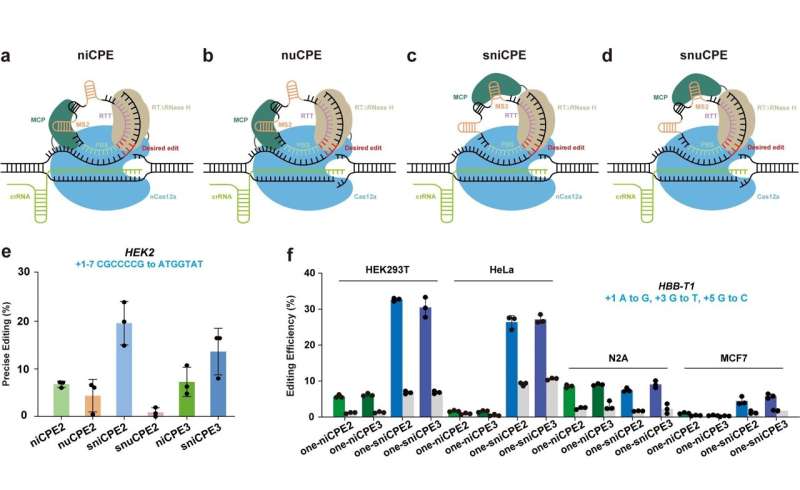This article has been reviewed according to Science X's editorial process and policies. Editors have highlighted the following attributes while ensuring the content's credibility:
fact-checked
peer-reviewed publication
trusted source
proofread
Researchers develop prime editors using Cas12a and circular RNAs in human cells

In a study published in Nature Biotechnology, Gao Caixia's group from the Institute of Genetics and Developmental Biology of the Chinese Academy of Sciences has developed a series of new prime editors based on the Cas12a protein, further expanding the targeting scope and applications of precision genome editing.
Prime editing (PE) enables precise, targeted DNA insertions, deletions, and replacements. To date, all efficient prime editors have been based on Cas9. However, the Cas9 has certain disadvantages that limit the broad application of prime editors. For example, it is too large, experiences higher levels of off-target editing, and has limited effectiveness in G/C-rich regions.
Addressing these problems would extend the utility of prime editing and enable more versatile genome edits. Compared with Cas9, the Cas12a protein and its crRNA have a smaller molecular size and are easier to deliver. Furthermore, Cas12a has a lower off-target effect and is better able to target A/T-rich regions due to its unique T-rich PAM preference. Therefore, prime editors based on Cas12a will have a wide range of potential applications.
Cas12a protein is known to cleave and process their own crRNA, making them unsuitable for use with traditional pegRNAs since they would cleave the extensions of primer binding site (PBS) and reverse transcriptase template (RTT).
Using different mutant versions of the Cas12a protein, the researchers developed a suite of different Circular RNA-mediated Prime Editors (CPEs) for various editing scenarios: a nickase-dependent CPE (niCPE), a nuclease-dependent CPE (nuCPE), a split nickase-dependent CPE (sniCPE), and a split nuclease-dependent CPE (snuCPE).
According to the researchers, the nuCPE and snuCPE achieved high editing efficiencies in HEK293T cells of up to 10.42% and 3.19%, respectively. The niCPE and sniCPE editors achieved even higher editing efficiencies—24.89% and 40.75%, respectively.
In addition to editing HEK293T cells, niCPE and sniCPE were also effective at performing precise edits in HeLa, N2A, and MCF7 cells. Importantly, by separating the reverse transcriptases, the sniCPE and snuCPE systems can eventually be delivered using AAV systems.
The researchers demonstrate effective multiplex prime editing by expressing all RNAs containing circular RNA simultaneously under one promoter. Using this approach, they demonstrate effective prime editing of two, three, or even four genes.
Finally, the researchers evaluated the off-target effects of the CPEs and showed that the CPEs indeed exhibit excellent specificity. The newly developed suite of CPE systems with low off-target effects and high editing efficiency provides guidance for the development of future prime editors that employ other nucleases and are diverse in size and targeting capabilities.
Ultimately, these CPE systems will have great potential in biological research, disease treatment, and crop breeding.
More information: Ronghong Liang et al, Prime editing using CRISPR-Cas12a and circular RNAs in human cells, Nature Biotechnology (2024). DOI: 10.1038/s41587-023-02095-x
Journal information: Nature Biotechnology
Provided by Chinese Academy of Sciences




















